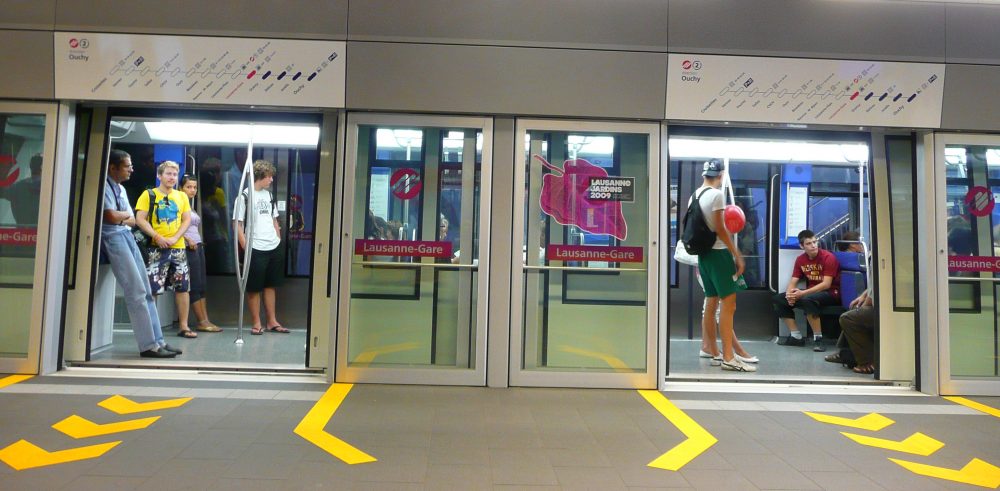Rey Camille and Berger Iman
17.01.2019
_________________________________
In this research paper, we will continue investigating multilingualism, focusing on the restaurants and cafés in the center of Lausanne. The goal of this study is to analyze how multilingualism is used as a business strategy in those establishments. In order to carry out this investigation, we went to this neighborhood to take pictures of visible written marks of multilingualism. After this first step, we had to analyze our pictures and understand how and for which reasons several languages were used in these places. We then came with different categories: using multilingualism in order to convey authenticity, or adopting multilingualism in a trendy way to appeal the customers by employing English. This inquiry allowed us to become aware of the predominance of multilingualism nowadays and that this phenomenon is often used for specific purposes by the commercial establishments. Our results show that multilingualism is both used either to express the authenticity of the restaurant/café, or, by using English, to appeal customers in a trendy way since English became very popular and is increasingly used.
_________________________________
Introduction
The academic interest in the urban linguistic landscape has grown over the past few years. Effectively, linguists have investigated multilingualism in order to have a better understanding on how and why cities use different languages nowadays. Indeed, cities such as Lausanne are interesting places to investigate due to the great concentration of people in them and to the contact of languages resulting from it. In this way, language appear as an indicator of global processes on the ground. By choosing a city in Switzerland which is a multilingual country by nature because of its different national languages (French, German, Italian and Romansch) we thought that it was interesting to investigate how the businesses use different languages and for which reasons. The aim of this research is to analyze multilingualism in public areas in the center of the city of Lausanne. More specifically, what is the purpose for businesses to use different languages? Would it be either a manner to express authenticity or rather a way to follow the trend by using English? Therefore, we will analyze the use of different languages and to which strategy it corresponds. In addition, a theoretical framework will be provided in order to introduce the main aspects and shed light on our own concepts. Indeed, previous studies as Piller’s (2001) have investigated the use of multilingualism in advertising. Her analysis focused on advertising mixing German and English and revealed that English was more and more used in the twentieth century. Moreover, another study on restaurants’ strategies to use several languages to keep the authenticity of the restaurant offer diverse interesting points that have been also raised in our research. In addition to these previous studies, we have also collected information from Jasone Cenoz and Ulrike Jessner’s article on the spread of English in the world because “English as a lingua franca” is one of the main point of this analysis, since it consists of one of the reason many establishments use multilingualism. In order to collect our data, we first went to the center of Lausanne around the “Place de la Louve” and “Place Pépinet” to observe the written language used in this place and to collect pictures of several restaurants and cafés’ windows displays and their respective advertisements where multilingualism would appear. Then, an analysis was conducted in order to analyze which restaurant use and expose different languages in their menu, panels, window displays and especially why they would do this. To answer our research question, a quantitative and qualitative analysis will be done on the basis of our selected pictures, followed by a discussion, a conclusion and potential opening on this research.
Theoretical framework
Firstly, we have taken an interest on Piller’s study made in 1999 which is about multilingualism in advertising and thus give an overall analysis on how English is used. She based her analysis especially on the German advertisements and interrogated the role of media on the expansion of the use of bilingualism (German and English). She thus noticed a “concomitants shift from monolingual practices to multilingual and English-dominant ones.” (Piller 2001: 153) In her article, she explores one linguistic discourse within the discourse of advertising which is the use of multilingualism. She notices that “contemporary cultural identities are hybrid, complex, and often contradictory, and the media play a crucial role in their configuration.” (2001: 155) She also agrees with other linguists on the fact that advertising is now continuing to integrate the creation of consumer identities, which have “become global and transnational” (2001: 155). In relation to our research, we can observe that eighteen years after her article, her conclusion was coherent with our results; and that nowadays, in advertisement and also in the street (cafés and restaurant) multilingualism has largely spread.
Alana Anne Colton, Amy Brenndorfer, Olivia Katie Colvin and Lucy Hannah Cook’s research outlines similarities regarding our specific focus on cafés and restaurants. Despite having investigated deeper in this subject, they have also looked at the different restaurants’ strategies set up to keep authenticity, regarding the language used within the institution. Their first main aim was to look if and how language is used as marketing strategy in the Italian Restaurant “P”, centered in Manchester. In addition to this, they also examined if the language used by the staff affects or not the customer’s dining experience. By focusing their analysis on this notion of authenticity, which is one of our key point, they give an adequate definition of this term, which is “something that is made or done in the traditional or original way or in a way that faithfully resembles to the original.’’ (Colton, Brenndorfer, Colvin Cook 2014: 2). Having carried different quantitative and qualitative methods such as questionnaires, interviews and observation, they realized that the language used in the restaurant, Italian, does definitely help to create an authentic atmosphere for the customers. In fact, almost 94% of the staff use both English and Italian to speak with the clients. Colton, Brenndorfer, Colvin and Cook’s conclusion is that the use of Italian is a strategy to keep identity and the restaurant’s authenticity.
Finally, in order to collect information about the spread of English and its expansion over time, we chose to read Jason Cenoz and Ulrike Jessner’s article (2000). In this article, we learned that the growing and expansion of multilingualism is a reaction to “people who need to be bilingual or multilingual in their daily communicative functions or who consider that they, or their children, have a potential need for it.” (2000: 3). English has, in fact, spread due to colonialism but has maintained for other reasons. Other languages have spread with colonialism, like Spanish and French. However, they differ in the “speed and extent of its growth also in mainly monolingual countries in the Middle and Far East, and in many parts in Europe.” (2000: 5). English has quickly become a “lingua franca used in several activities like trade, tourism, air travel, popular media, sport, science, technology and many other fields of importance in contemporary life.” (Cenoz and Jessner 2000: 5). It is important to discern their observation made in 2000 from ours made in 2018. Cities, in almost 20 years have developed, and Lausanne has also become an important city with more and more international communities. They, however, already observed that “English had become visible throughout Europe and beyond a large number of domains such as commerce (…) and tourism.” (2000:10). They also noticed that it had become the “dominant language of advertising, especially for consumer goods” (2000:10) which support our observations made in this paper.
Contextualization
To answer our research question on the linguistic landscape, we have chosen to focus mainly on a certain type of establishments which is the restaurants, cafés and food businesses in the center of the city of Lausanne. Indeed, by walking around the center of Lausanne, we have noticed that several of those establishments were using different languages in their brand names, menus, slogans, etc. Obviously, due to their geographical position in the center of the city, those restaurants and cafés are more visible and thus might attract and ‘’welcome’’ a larger customer type with different nationalities, for example.
In fact, Lausanne is in full development, regarding the economy, urban planning, public transport and mobility which are sectors in continual change. As a popular tourist destination, this capital also contains a larger number of different international companies. By hosting the International Olympic Committee and other international agencies, Lausanne is an important city. In fact, this city is really involved in supporting its inhabitants and has thus set up several political programmes to help integration. On the strength of this support policy, the city has also engaged an integration policy for foreign populations. Regarding its demography and ethnolinguistic groups, Lausanne is a city in the French-speaking part of Switzerland, which is also the capital and the biggest city of the Canton de Vaud. Nevertheless, although this city includes a total of 145’892 inhabitants (October 2018), 62’631 of them have not the Swiss nationality, which is nearly the half of the total. In 2017, 40’648 of the non-Swiss people were originated from the European countries. However, from the 1980 and nowadays, the number of Asians and North Americans has significantly grew. Despite the fact that the nationality does not necessarily reflect the linguistic repertoires, it still gives an idea on the diversity in Lausanne.
Nowadays, this centered district (fig.1) became more and more popular through time with its many restaurants, cafés and also shops and commerce. Undoubtedly, this district might be known and attended by mostly everyone from different countries and nationalities.
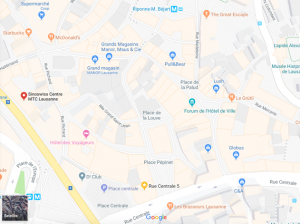
Figure 1: map of our research district from Google maps
Methodology
By walking around in the central neighborhood of Lausanne, we were surprised to see how many cafés and restaurants use multilingual signs. We decided to go in the center, since it would be surely in this specific area that we would find more interesting ‘’examples’’ of multilingualism than in another neighborhood which is less used. We initially started to analyze the commercial discourse and signs of both shops and restaurants/cafés, by looking at the brands, the window displays, the signs and notice boards in front of the establishment. Nonetheless, realizing that our data would be too broad, we decided to focus only on the different establishments which provide food and drink. Since those businesses have to attract people in order to get customers and to run their business, they have to use different strategies regarding their written public discourse, on the window displays for example. Indeed, using multilingual signs could either be a strategy to attract the eye of the potential customer, or to reflect the nationality of their product and to maintain their authenticity. Therefore, we started first to take pictures from the street, mainly of the window displays, the brand names and also of some notice boards promoting a specific product. Then, in order to complete our analysis, we decided to collect more data by going inside the institutions, taking pictures of the menus and even asking extra information by talking to the waiters/sellers. In this manner, we decided to look at which languages the establishment use, how those languages are presented (hierarchy, size, colors, …) and for what purpose. Our data is thus made up of eight different institutions in the center of Lausanne, divided in restaurants, cafés or shops that sell food or drinks as ‘’take-away’’.
Considering Lausanne as a city that contains a lot of migrants, we were not so surprised to find many different types of signs in different languages. Including people from different nationalities, this seems natural that the establishments address the customers in many languages in the menus or the written signs. Moreover, as English has become an international language, we were not surprised by the numerous English brand names which, most of the time, outline a way to follow a trend.
Results and Discussion
We realized that Multilingualism was used for two different purposes. Thus, we grouped the different restaurants and cafés into three distinct categories: first, the ones which use another language in order to keep their authenticity; second, the ones that use multilingual signs mostly in English (L2) as a marketing strategy to attract customers by following the trend; and finally, the ones who appear to mix both of these two strategies. As presented in the graph below (fig.2), the idea of maintaining authenticity is slightly above the use of English as a lingua franca. Having delimited three categories, we will now proceed to the analysis and discussion of those results.
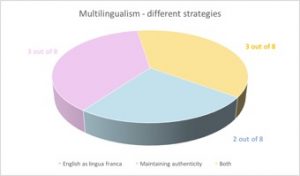
Figure 2: Graph on the different strategies by using multilingual written signs
Maintaining authenticity
Firstly, focusing on the notion of authenticity, we have selected the restaurant “Le Central 5” which has a neon light on its front wall where it is written: “Central Park”. This neon actually comes from the original name of the restaurant opened in the 1970s, “period in which the American culture was trendy”, as affirmed the waiter of the restaurant. What is more, they do not only maintain the authenticity of the previous restaurant, but also the authenticity in their menu. Indeed, they keep the original name of the food they serve: “chicken” in English (fig.3), and “carne de porco alentejana” in Portuguese.
Figure 3: Central 5’s menu
Another commerce that uses language in order to convey it authenticity is the “Pida Bar”. In this case, it is not English that is used, but Italian. Italian is here used in order to reflect the origin of the products they sold. The term ‘’Pida’’ is a romagnol dialect which is also intriguing. We also noticed that besides using Italian local products, they also transmitted their origin in the front window, by using the colors of the Italian flag. Nevertheless, we can still notice that there is a mark of English (‘’take away’’) which reflects this trend of ‘’fastness’’ that appears nowadays in our society.

Figure 4: The Pida Bar – window display
The last café we classed in this category is actually an international brand, “Starbucks Café”. Because it is an international chain which initiated in America (Seattle), we can observe that they will always keep the same strategy in all their cafés: the names of their articles (coffee, food, tea, objects) are in English, thus intensifying their origin. What is more, they sell American type products (cinnamon rolls, bagels, muffins, donuts, …). Nevertheless, the slogans directly addressed to the customers will be adapted to the native language of the city the Starbucks is based, which is in the case of Lausanne, French.
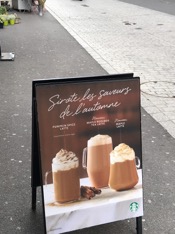
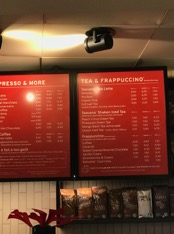
Figure 5 and 6: Starbucks’ sign in the street + menu in the café
English as a lingua franca
The second category regroups institutions using English, because it is an international language, as a tendency that has spread these past few years. For example, the case of the restaurant “Luncheonette” which uses English, not only on the window display, but also in its menu. First of all, as they mix a large number of meals from different nationalities in their menu (“Wraps grillés”: “Quesadilla”, “Jimmy le Grec”, “La Créole”, …), the strategy “maintaining authenticity” is abandonned due to the fact that they do not focus on a specific nationality. Therefore, English is in this case used to follow a sort of trend, because this international language is nowadays understood by most people in this region of the world.
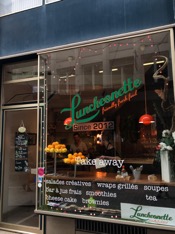
Figure 7: Luncheonette – window display
Another café that uses English as a lingua franca is “Tekoe”. This Swiss brand of coffee shop uses English to describe the characters of the products on the packaging as this language is international. What is more, because Switzerland is composed of four national languages (German, French, Italian and Romansh), they had to make a selection of the languages that appear on their products label. Consequently, due to aesthetic and marketing design reasons, they favored the English language. Indeed, as the manager of the shop told us, English language is definitely more direct and easy to use than any other language. Moreover, their expansion in Spain and the online selling of their products influenced their choice of using English as an international language. As she said: “Internet sales does not have boundaries and therefore needs an international language that everybody can understand.”
Using both strategies
Finally, some of the establishments we visited use both of these strategies. It is the case of “Mexicana” which uses some Spanish words in order to convey their authenticity. In fact, the Mexican authenticity is expressed through colors and drawings on the wall (see fig.8). However, it is French that is used in the menu since it is the native language in the city. On the other hand, we have noticed that English is used in the slogan “Taco Tuesday”, which refers to a special offer they have that day of the week. The use of English rather than French is probably due to the alliteration that the ‘t’ produces.
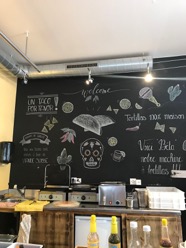
Figure 8: Mexicana – writings on the wall
Another example of the use of multilingualism as both strategies is the Chinese restaurant “Chinatown”. The most striking use of multilingualism are the Chinese signs, not only in the front of the restaurants, but also on the menu. There is so a clear claiming for their authenticity as a Chinese restaurant. In addition, they also use French (the most spoken language in Lausanne) and, German; in order to refer to the two main languages used in Switzerland. Thus, it shows their will to reach a large amount of people. Interestingly, despite the fact that there are already three strong languages presented in their menu, English still appears due to its status as lingua franca.
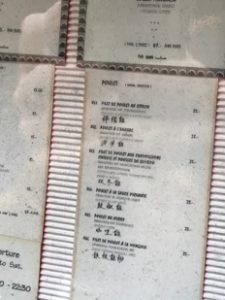
Figure 9: Chinatown – menu
The last café we visited was the “Black Bird Café” which also uses English in its name (like Chinatown). This café actually uses English language in order to reflect the authenticity of their English breakfast and other meals from the American/ English culture: pancakes, milkshakes, bacon, peanut butter, …. However, something that surprised us was the manner they ‘’code-switch’’ between English and French in the menu. In fact, for example, the titles of the menu are in English, but the description are in French. In this way, the use of English seems to be used in order to catch the attention of the customer, in a trendy way.
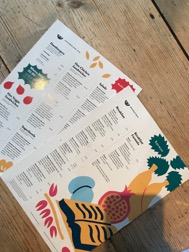
Figure 10: Black Bird Café’s menu
Having analyzed and categorized all our data, we came up with the main and general observation that multilingualism is mostly present everywhere and that most of the time it occurs between English and another language L2. In addition, as we can observe through the graph (fig.2), multilingualism is rather used as a strategy to express authenticity. Nevertheless, it is important to be conscious that the results found are subtly different (3 vs. 2: which is a very small difference), due to the limited sample of data, and thus our results have to be taken carefully.
Conclusion
Keeping in mind that we have mainly focused on the restaurants and cafés in the center of Lausanne, we tried to understand how and why multilingualism was used in those establishments. Throughout the analysis of our data, we came to the realization that multilingualism was used conforming to specific strategies. Actually, multilingualism is either a way to reflect the authenticity of the establishment, or a manner to follow the tendency of using English. In fact, we have observed that English was one of the most present language due to its important position as a lingua franca nowadays. Nonetheless, due to our selective choice of data, we obviously cannot make an overall conclusion as there are so many other restaurants and cafés centered in this district. In order to enlarge our research, as our analysis is only external and based on our own observation, we could eventually go back in the selected institutions, get interviews with the staff or the customers, observe the customers’ linguistic repertoires for example, in order to confirm our results or not. Nevertheless, now that we have produced this research, we realized how omnipresent multilingualism is all around us, on each street corner, and that it could be interestingly used as different strategies for commerce.
References
Cenoz, J. & Jessner, U., 2000. English in Europe: The Acquisition of a third Language: The Spread of English. Clevedon, Buffalo, Toronto, Sydney: Multilingual Matters,
Colton A., Brenndorfer A., Colvin O. K. & Cook L. H., 2014. An analysis of multilingualism in two Manchester branches of Restaurant P. Multilingual Manchester,1-14. Available at: Google Books, http://mlm.humanities.manchester.ac.uk/wp-content/uploads/2015/12/An-Analysis-of-multilingualism-in-two-Manchester-branches-of-restaurant-P.pdf (26.12.18).
Piller, I. 2001., “Identity construction in multilingual advertising”, Language in Society, volume. 153- 186
Short history of Lausanne, available at: https://en.wikipedia.org/wiki/Lausanne Accessed on: 05.12.2018.
Ville de Lausanne, “Contrôle des habitants” Available at: http://www.lausanne.ch/lausanne-officielle/administration/securite-et-economie/controle-des-habitants/statistiques/evolution-mensuelle-nombre-habitants-en-2018.html Accessed on: 05.12.18.
Ville de Lausanne, “Etat et structure de la population totale” Available at: https://www.lausanne.ch/officiel/statistique/themes/01-population.html Accessed on: 05.12.2018.
